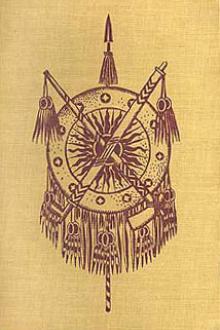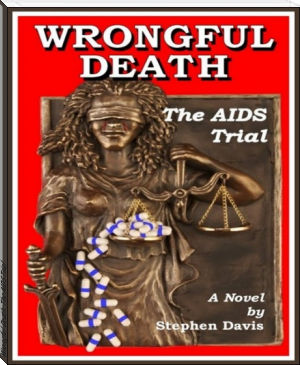The Oregon Trail, Francis Parkman [ebook reader online TXT] 📗

- Author: Francis Parkman
- Performer: -
Book online «The Oregon Trail, Francis Parkman [ebook reader online TXT] 📗». Author Francis Parkman
The chief difficulty in running buffalo, as it seems to me, is that of loading the gun or pistol at full gallop. Many hunters for convenience’ sake carry three or four bullets in the mouth; the powder is poured down the muzzle of the piece, the bullet dropped in after it, the stock struck hard upon the pommel of the saddle, and the work is done. The danger of this method is obvious. Should the blow on the pommel fail to send the bullet home, or should the latter, in the act of aiming, start from its place and roll toward the muzzle, the gun would probably burst in discharging. Many a shattered hand and worse casualties besides have been the result of such an accident. To obviate it, some hunters make use of a ramrod, usually hung by a string from the neck, but this materially increases the difficulty of loading. The bows and arrows which the Indians use in running buffalo have many advantages over fire arms, and even white men occasionally employ them.
The danger of the chase arises not so much from the onset of the wounded animal as from the nature of the ground which the hunter must ride over. The prairie does not always present a smooth, level, and uniform surface; very often it is broken with hills and hollows, intersected by ravines, and in the remoter parts studded by the stiff wild-sage bushes. The most formidable obstructions, however, are the burrows of wild animals, wolves, badgers, and particularly prairie dogs, with whose holes the ground for a very great extent is frequently honeycombed. In the blindness of the chase the hunter rushes over it unconscious of danger; his horse, at full career, thrusts his leg deep into one of the burrows; the bone snaps, the rider is hurled forward to the ground and probably killed. Yet accidents in buffalo running happen less frequently than one would suppose; in the recklessness of the chase, the hunter enjoys all the impunity of a drunken man, and may ride in safety over the gullies and declivities where, should he attempt to pass in his sober senses, he would infallibly break his neck.
The method of “approaching,” being practiced on foot, has many advantages over that of “running”; in the former, one neither breaks down his horse nor endangers his own life; instead of yielding to excitement he must be cool, collected, and watchful; he must understand the buffalo, observe the features of the country and the course of the wind, and be well skilled, moreover, in using the rifle. The buffalo are strange animals; sometimes they are so stupid and infatuated that a man may walk up to them in full sight on the open prairie, and even shoot several of their number before the rest will think it necessary to retreat. Again at another moment they will be so shy and wary, that in order to approach them the utmost skill, experience, and judgment are necessary. Kit Carson, I believe, stands pre-eminent in running buffalo; in approaching, no man living can bear away the palm from Henry Chatillon.
To resume the story: After Tete Rouge had alarmed the camp, no further disturbance occurred during the night. The Arapahoes did not attempt mischief, or if they did the wakefulness of the party deterred them from effecting their purpose. The next day was one of activity and excitement, for about ten o’clock the men in advance shouted the gladdening cry of “Buffalo, buffalo!” and in the hollow of the prairie just below us, a band of bulls were grazing. The temptation was irresistible, and Shaw and I rode down upon them. We were badly mounted on our traveling horses, but by hard lashing we overtook them, and Shaw, running alongside of a bull, shot into him both balls of his double-barreled gun. Looking round as I galloped past, I saw the bull in his mortal fury rushing again and again upon his antagonist, whose horse constantly leaped aside, and avoided the onset. My chase was more protracted, but at length I ran close to the bull and killed him with my pistols. Cutting off the tails of our victims by way of trophy, we rejoined the party in about a quarter of an hour after we left it. Again and again that morning rang out the same welcome cry of “Buffalo, buffalo!” Every few moments in the broad meadows along the river, we would see bands of bulls, who, raising their shaggy heads, would gaze in stupid amazement at the approaching horsemen, and then breaking into a clumsy gallop, would file off in a long line across the trail in front, toward the rising prairie on the left. At noon, the whole plain before us was alive with thousands of buffalo—bulls, cows, and calves—all moving rapidly as we drew near; and far-off beyond the river the swelling prairie was darkened with them to the very horizon. The party was in gayer spirits than ever. We stopped for a nooning near a grove of trees by the river side.
“Tongues and hump ribs to-morrow,” said Shaw, looking with contempt at the venison steaks which Delorier placed before us. Our meal finished, we lay down under a temporary awning to sleep. A shout from Henry Chatillon aroused us, and we saw him standing on the cartwheel stretching his tall figure to its full height while he looked toward the prairie beyond the river. Following the direction of his eyes we could clearly distinguish a large dark object, like the black shadow of a cloud, passing rapidly over swell after swell of the distant plain; behind it followed another of similar appearance though smaller. Its motion was more rapid, and it drew closer and closer to the first. It was the hunters of the Arapahoe camp pursuing a band of buffalo. Shaw and I hastily sought and saddled our best horses, and went plunging through sand and water to the farther bank. We were too late. The hunters had already mingled with the herd, and the work of slaughter was nearly over. When we reached the ground we found it strewn far and near with numberless black carcasses, while the remnants of the herd, scattered in all directions, were flying away in terror, and the Indians still rushing in pursuit. Many of the hunters, however, remained upon the spot, and among the rest was our yesterday’s acquaintance, the chief of the village. He had alighted by the side of a cow, into which he had shot five or six arrows, and his squaw, who had followed him on horseback to the hunt, was giving him a draught of water out of a canteen, purchased or plundered from some volunteer soldier.
Recrossing the river we overtook the party, who were already on their way.
We had scarcely gone a mile when an imposing spectacle presented itself. From the river bank on the right, away over the swelling prairie on the left, and in front as far as we could see, extended one vast host of buffalo. The outskirts of the herd were within a quarter of a mile. In many parts they were crowded so densely together that in the distance their rounded backs presented a surface of uniform blackness; but elsewhere they were more scattered, and from amid the multitude rose little columns of dust where the buffalo were rolling on the ground. Here and there a great confusion was perceptible, where a battle was going forward among the bulls. We could distinctly see them rushing against each other, and hear the clattering of their horns and their hoarse bellowing. Shaw was riding at some distance in advance, with Henry Chatillon; I saw him stop and draw the leather covering from his gun. Indeed, with such a sight before us, but one thing could be thought of. That morning I had used pistols in the chase. I had now a mind to try the virtue of a gun. Delorier had one, and I rode up to the side of the cart; there he sat under the white covering, biting his pipe between his teeth and grinning with excitement.
“Lend me your gun, Delorier,” said I.
“Oui, monsieur, oui,” said Delorier, tugging with might and main to stop the mule, which seemed obstinately bent on going forward. Then everything but his moccasins disappeared as he crawled into the cart and pulled at the gun to extricate it.
“Is it loaded?” I asked.
“Oui, bien charge; you’ll kill, mon bourgeois; yes, you’ll kill—
c’est un bon fusil.”
I handed him my rifle and rode forward to Shaw.
“Are you ready?” he asked.
“Come on,” said I.
“Keep down that hollow,” said Henry, “and then they won’t see you till you get close to them.”
The hollow was a kind of ravine very wide and shallow; it ran obliquely toward the buffalo, and we rode at a canter along the bottom until it became too shallow, when we bent close to our horses’
necks, and then finding that it could no longer conceal us, came out of it and rode directly toward the herd. It was within gunshot; before its outskirts, numerous grizzly old bulls were scattered, holding guard over their females. They glared at us in anger and astonishment, walked toward us a few yards, and then turning slowly round retreated at a trot which afterward broke into a clumsy gallop.
In an instant the main body caught the alarm. The buffalo began to crowd away from the point toward which we were approaching, and a gap was opened in the side of the herd. We entered it, still restraining our excited horses. Every instant the tumult was thickening. The buffalo, pressing together in large bodies, crowded away from us on every hand. In front and on either side we could see dark columns and masses, half hidden by clouds of dust, rushing along in terror and confusion, and hear the tramp and clattering of ten thousand hoofs. That countless multitude of powerful brutes, ignorant of their own strength,





Comments (0)